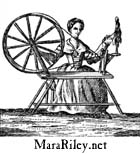|
|
 |
|
|
Hand-knitting in the 18th century seems to have been confined to objects such as stockings, hats, mittens or gloves, and the occasional knitted undershirt. These objects all have one thing in common: they need some stretch, and need to fit odd shapes well. Items such as scarves, shawls (wraps), etc. were not knitted in the 18th century. There is some debate in 18th century reenacting circles about the proper gauge of 18th century knitting, but I think that question is misguided -- the answer will vary depending on the item being discussed (see the paragraph here on the gauge for period stockings). Period stockings were generally knitted with a gauge somewhere between 7 stitches per inch all the way up to 30 or more stitches per inch (with the finest gauges being knitted by machine), with many examples in the 9 to 15 stitches per inch range. Some surviving examples of period hats and mittens, on the other hand, seem to have been knitted in a larger gauge. Tools: Knitting sheaths of various sorts were used
throughout the British Isles and Europe from the 17th
through the 19th centuries (Rutt, pp. 20, 125-126). They held
the knitter's working needle, freeing that hand to throw the yarn
more quickly. Primitive examples could be made from hen's feathers
bundled together with string, or bundles of twisted straw; finer versions
were made of silver or fine woods like mahogany. Whisks or knitting belts were used by production knitters in the Shetlands in the 19th and possibly the 18th centuries to speed up the knitting process. A picture of a knitting belt in use is shown here. Reproductions can be purchased from Journeyman Leather and Four Seasons Knitting. Stockings Men's Knitted Caps & Scots Bonnets Mittens and Gloves A pair of heavily fulled gloves was found with the Gunnister bog body, which dates to the late 17th century (see Pulliam, cited above). The gauge of these gloves is 17 stitches and 14 rows per inch (i.e., they were knitted at a larger gauge and then shrunk to size). More thorough descriptions of the Gunnister items (caps, pouch, stockings and gloves) and Scots bonnets can be found in Early Textiles Found in Scotland and Stuart Clothing and Other Articles from a late 17th Century Grave at Gunnister, Shetland by Audrey S. Henshall, in the Proceedings of the Society of Antiquaries of Scotland, Vol. 86, and in Gunnister Man's Knitted Posessions, by Deborah Pulliam in Piecework, September/October 2002. A pair of knitted elbow-length, fingerless linen
mitts, dated 1787, is posted on Karen Augusta's website. A knitted women's jacket dating to the late 17th or early 18th century is in the Victoria & Albert Museum's collection (Hart & North, p. 186-7); such jackets may have been worn for casual wear around the house and during convalescence after childbirth. The same book also shows (p. 188) a knitted petticoat, with more than two thousand stitches cast on for the hem. I don't, at present, know of any knitters insane enough to try to duplicate it. It may have been made for a guild, and has never been worn. A similar petticoat is in the collection at LACMA. Two knitted infants' jackets are shown on page 159 of What Clothes Reveal by Linda Baumgarten; these probably date to the late 17th to early 18th centuries. A mid-18th century baby's jacket knitted in cotton is shown on p. 26 of Helen Bennet's Scottish Knitting; similar jackets are in the collection of various museums, including the Victoria & Albert Museum. Other Items There is a reference to knitted garters circa 1711 on p. 88 of Rutt. Pincushions of various sorts were knit, usually in silk. Here is an example of an English pinball from the early 19th century with Quaker provenance, offered for sale at http://www.samplings.com/. The Gunnister bog find also included a knitted pouch. I don't
know of any other surviving examples of 17th or 18th century examples
of knitted pouches, though various knitted pouches are known from
earlier periods, and there are numerous references to knitted purses
in period documents. |
|
Other Online Knitting Resources: Books on Knitting: |
|
|
References: Thanks to Katheleen Manneke for pointing me to various examples
of period knitting, and to Deborah Pulliam for correcting errors.
|
|
|
A few words on crochet and tatting: Both crochet and tatting are 19th century techniques. There are a few books around that talk about crochet and tatting dating back to the 15th century or earlier, but so far, those who have looked for or looked at the textiles in question either find that they're nonexistent or are mislabled needle lace or knotting (which are not the same as tatting), or nalbinding (which can look a little like crochet but is really not the same thing). An essay on the subject, written by someone much more knowledgeable on the subject than I am, can be found in the files of the Historic Knitting List. If you can find actual existing objects (not just a second- or third-hand reference in an arts and crafts book) made with tatting or crochet dating earlier than the 19th century, I'm sure the folks there would be happy to see the evidence.
|
|
|
|
|
